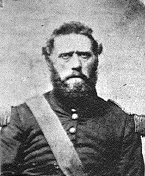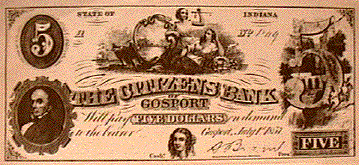
Facts
Did You Know?
- The 27th Indiana had the tallest soldiers of the Civil War?
David C. Van Buskirk of Company F was 6'10.5" tall and was also
the single tallest soldier in on either side. This would be about
7'4" inches today by comparison. He was called the 'Biggest Yankee
in the World' by the Southern press. When captured at Winchester
on 25 May, 1862, David was sent to the infamous Libby Prison in
Richmond. He attracted the attention of none other than
Confederate President Jefferson Davis. On a visit to the prison,
Davis asked about his home and family. "Back home at Bloomington
Indiana," answered Van Buskirk, "I have six sisters. When they
told me goodbye, as I was standing with my company, they all
walked up, leaned down, and kissed me on top of the head." David
was paroled in September of 1862 and took command of Company F
when Peter Kopp was killed at Antietam. Company F boasted 35 men
over six feet. Incredibly, as large a target as David might
present, he was never wounded. He served with the regiment until
April 1864.
 Biggest Soldier in the Civil War:
Captain David Van Buskirk
Biggest Soldier in the Civil War:
Captain David Van Buskirk
- The 27th Indiana coined the phrase, "Gosport Money" as a
popular Civil War term meaning something of absolutely no value?
The term resulted from an overaggressive sutler disregarding
Colonel Colgrove's strict rules about entering the 27th's camp at
Frederick, Maryland in the Winter of 1862-63. The sutler bypassed
Colgrove's guards and entered the camp with his shoddy or
high-priced wares. He had no idea that several soldiers from
Company F had brought with them large sums of worthless, unsigned
bank notes from a failed bank in Gosport, Indiana. Never intending
to use the notes as actual currency, the perpetrators could not
resist to put one over on this 'thief.' The sutler was amazed to
see how readily the boys bought up his goods and seemed to have
lots of cash to boot (signed by their peers). He left camp in an
empty wagon and in high spirits. You can imagine his horror when
he learned the real value of the notes when he attempted to
deposit them. You can also imagine the sympathetic ear he received
when he complained to the Colonel shortly thereafter. Needless to
say, the Colonel sent him on his way empty handed once more, but
after a good swearing and cursing about the matter. Soon, word of
the incident spread throughout the Army of the Potomac and among
many banks and sutlers.
 A Gosport Note
A Gosport Note

- The 27th Indiana was instrumental in changing the course of
the Civil War? By finding Lee's Lost
Order, the rebel invasion of
Maryland was doomed. President Lincoln stated after the bloody
battle, "God had decided the question in favor of the slaves," and
issued his Emancipation Proclamation. Foreign powers were deeply
affected by the proclamation. From this point, no foreign power
was willing to embrace the Confederacy with slavery as an
institution. The rest is history, all because John M. Bloss and
Barton W. Mitchell found three cigars wrapped with Special Orders
191 in a clover field at their old campsite in Frederick,
Maryland.
Special Orders 191
- The 27th Indiana
fought in six major campaigns and eleven major engagements? Its
combat death loss from so many severe actions were among the top
20 in the Union Army, and the largest in 12th/20th Corps when
figured by percent of those enrolled. It stood its ground in
Miller's Cornfield at Antietam, forcing the 27th Georgia and
Colquitt's Brigade to retire. Along with its brigade, it checked
the advance of the rebel attack at Chancellorsville, allowing
fresh troops to stabilize the line, thus saving the Union forces
from total defeat. Its attack at Culp's Hill at Gettysburg
confused Ewell into thinking a Union assault was being launched,
causing Pickett's attack to be uncoordinated with the rebel left.
Its valor at Resaca, Georgia helped defeat Hood's attack on the
vulnerable Union left. In this battle it would capture the
colonel, colors and scores of prisoners from the 38th Alabama and
would add a Medal of
Honor to its ranks. In all of its
service, it never lost a color or a cannon under its care.
Incredibly, this unparalleled regiment escapes most historians'
notice outside of the lost orders incident. Without fancy names or
fancy hats, the 27th contributed blood and immeasurable service to
help preserve the United States of America and end human
suffering.
 Soldier's Monument, Dubois
County, Indiana
Soldier's Monument, Dubois
County, Indiana
Resources
Where to learn more about the 27th Indiana

|

|

|
|
|
General Alpheus S. Williams
|
|
Personal Accounts
"The Twenty-Seventh Indiana Volunteer Infantry," by Edmund
R. Brown (of Company C), 1899. The Official History. Reprinted by
Butternut Press, Gaithersburg, MD in 1980s. Original and Reprints are
extremely hard to find.
"Giants in the Cornfield," by Wilbur
D. Jones, Jr., 1997. White Mane Publishers, Shippenburg, PA. This is
the definitive work on the 27th Indiana. Captures the emotional and
social involvement of the men in their own words. Lets you see what
it was like to be in an infantry regiment during the war. This work
is not a rehash of the official history. Mr. Jones has unearthed
important new material, most of which is not in the official history.
Information on this work, including autographed copies, can be
obtained ($30 + $4 S&H )by writing:
|
Wilbur Jones Compositions
4700 Chamberlain Lane
Wilmington NC 28409
|

|
Or check out Mr. Jones web site at
www.wilburjones.com.
E-mail Wilbur Jones
"From the Cannon's Mouth," edited by Milo M. Quaife, 1959,
Wayne State Univ. Press, Detroit, MI. These are the wartime letters
of Alpheus S. Williams. This book is extremely hard to find but worth
the price. General Williams was the 27th Indiana's division commander
throughout the war. He commanded the XII Corps at Gettysburg and on
occasion in the Atlanta Campaign. Williams is truly one of the unsung
heroes of the war. You can read his letters, learn more about
Williams, and explore the 27th's parent units at Lowell Forest
Boileau's outstanding home page called "Plug
Ugly" (Williams' horse).
"Soldiering: The Civil War Diary of Rice C. Bull," edited
by K. Jack Bauer, 1977, Presidio, Novato, CA. Rice Bull was a member
of the 123d New York Infantry, which joined the 27th Indiana's
brigade from Chancellorsville through Atlanta. Contains many vivid
recollections of the Hoosiers.
General Reference
"A Compendium of the War of the Rebellion" by Frederick H.
Dyer (1908), reprints possibly available through Broadfoot
Publishing. Guild
Press includes this monumental work in their Official
Records CD-ROM.
"The War of the Rebellion: A Compilation of the Official
Records of the Union and Confederate Armies", There are a total
of 16 volumes of the Official Records that purport to contain some
mention of the 27th Indiana Infantry. The hardbacks are available
through Broadfoot
Publishing. The CD-ROM versions are offered by three
main suppliers. Guild
Press' version includes Dyer's Compendium, Fox's
Regimental Losses, Great Battles, and the Official Guide to the Use
of the Official Records.
"The Army of the Potomac," by Bruce Catton, 1962,
Doubleday, Garden City, NY. Mr. Catton features the 27th Indiana to
tell his story in this classic work.
"Campaigns of the Army of the Potomac," by William Swinton,
1866. Blue & Grey Press, Secaucus, NJ, offers a fine reprint of
this essential work.
"History of the Army of the Cumberland," by Thomas B. Van
Horne, 1875. Broadfoot
Publishing offers an excellent exact reprint (covers
and all) of perhaps the best large unit history to come out of the
war.
Battle Reference
"Stonewall Jackson at Cedar Mountain," by Robert K. Krick,
1990. This is the best description of the battle but some reviewers
feel it is done from the southern perspective.
"Antietam: The Photographic Legacy of America's Bloodiest
Day," by William A. Frassanito, 1978, Scribner's, New York, NY.
This book allowed me to walk directly to the exact sites where the
27th fought. Best in-depth study available.
"Chancellorsville," by Stephen W. Sears, 1996, Houghton
Mifflin, New York, NY. Finally, the history has been written that
explains the 27th's important role.
"Gettysburg: A Journey in Time," by William A. Frassanito,
1975, Scribner's, New York, NY. As good as the Antietam work. Details
the 27th Indiana and 2d Massachusetts attack at Spangler's Spring at
Culp's Hill.
"Gettysburg: Culp's Hill and Cemetery Hill," by Harry W.
Pfanz, 1993, UNC Press, Chapel Hill, NC. THE work on the 'other
Gettysburg.' Provides insight to the implications of the attack at
Spangler's Spring.
Internet Civil War Book
Sources
James
River Publications
Provides a good resource on the net for
where to find Civil War books. This site also includes a list of
every known Civil War Regimental
History published.
Well, that's all I have for now. If you would like to add to this
list or comment on unique facts about the 27th Indiana, please e-mail
Steve Russell.
[ Main Page | Lee's Lost
Order | Brief_History |
Regimental Photo
Album | Uniforms &
Weapons ]
[ Flags | Graves | Battles &
Engagements | Facts &
Resources | Dedication | Ancestral Links &
e-mail ]










